indicator Citroen GRAND C4 PICASSO 2017 2.G Repair Manual
[x] Cancel search | Manufacturer: CITROEN, Model Year: 2017, Model line: GRAND C4 PICASSO, Model: Citroen GRAND C4 PICASSO 2017 2.GPages: 527, PDF Size: 12.91 MB
Page 176 of 527

174
70
70
C4-Picasso-II_en_Chap04_conduite_ed02-2016
Driving situations and associated alerts
To benefit from all of the information available in the instrument panel, you must first select the "DRIVING" display mode.
The following table describes the alerts and the messages displayed for the different driving situations.
The display of these alerts is not sequential.Indicator Display Associated messageComment
according to the inter-vehicle
distance selected "Cruise control paused" System paused.
No vehicle detected.
according to the inter-vehicle
distance selected "Cruise control paused" System paused.
A vehicle has been detected.
according to the inter-vehicle
distance selected "Cruise control on"
System activated.
No vehicle detected.
according to the inter-vehicle
distance selected "Cruise control on"
System activated.
A vehicle has been detected.
or "Cruise control suspended"
System activated.
The driver has temporarily taken control of the vehicle by
accelerating.
Driving
Page 177 of 527
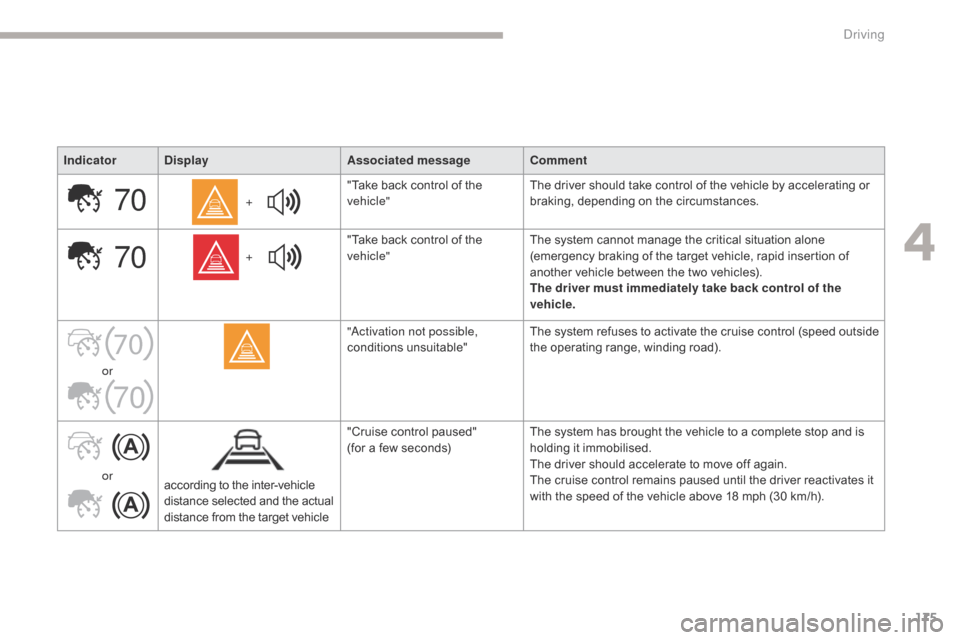
175
70
70
70
70
C4-Picasso-II_en_Chap04_conduite_ed02-2016
IndicatorDisplay Associated messageComment
+ "Take back control of the
vehicle"
The driver should take control of the vehicle by accelerating or
braking, depending on the circumstances.
+ "Take back control of the
vehicle"
The system cannot manage the critical situation alone
(emergency braking of the target vehicle, rapid insertion of
another vehicle between the two vehicles).
The driver must immediately take back control of the
vehicle.
or "Activation not possible,
conditions unsuitable"
The system refuses to activate the cruise control (speed outside
the operating range, winding road).
or according to the inter-vehicle
distance selected and the actual
distance from the target vehicle "Cruise control paused"
(for a few seconds)
The system has brought the vehicle to a complete stop and is
holding it immobilised.
The driver should accelerate to move off again.
The cruise control remains paused until the driver reactivates it
with the speed of the vehicle above 18 mph (30 km/h).
4
Driving
Page 183 of 527
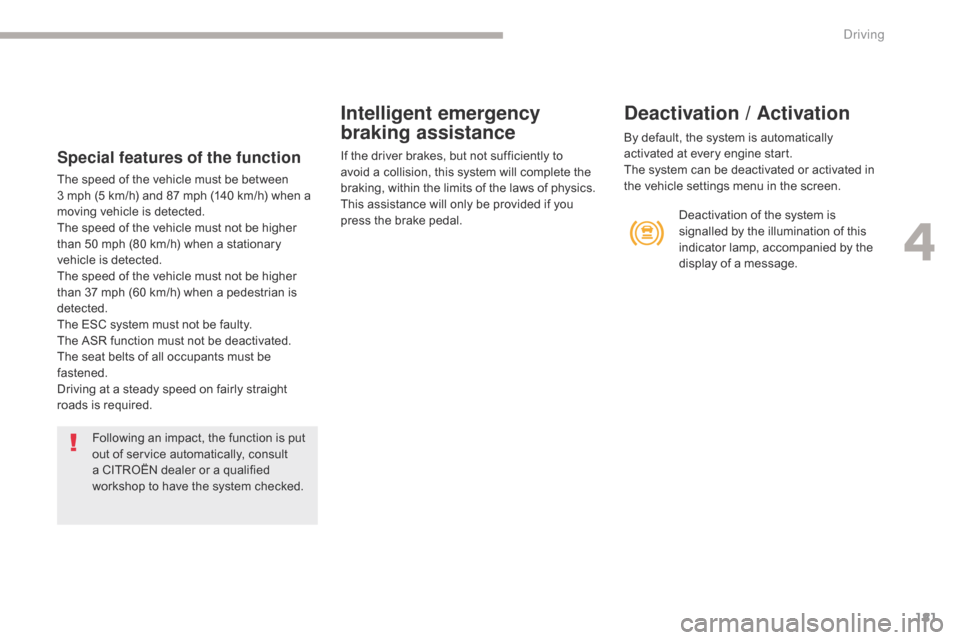
181
C4-Picasso-II_en_Chap04_conduite_ed02-2016
Special features of the function
The speed of the vehicle must be between
3 mph (5 km/h) and 87 mph (140 km/h) when a
moving vehicle is detected.
The speed of the vehicle must not be higher
than 50 mph (80 km/h) when a stationary
vehicle is detected.
The speed of the vehicle must not be higher
than 37 mph (60 km/h) when a pedestrian is
detected.
The ESC system must not be faulty.
The ASR function must not be deactivated.
The seat belts of all occupants must be
fastened.
Driving at a steady speed on fairly straight
roads is required.
Following an impact, the function is put
out of service automatically, consult
a CITROËN dealer or a qualified
workshop to have the system checked.
Intelligent emergency
braking assistance
If the driver brakes, but not sufficiently to
avoid a collision, this system will complete the
braking, within the limits of the laws of physics.
This assistance will only be provided if you
press the brake pedal.
Deactivation / Activation
By default, the system is automatically
activated at every engine start.
The system can be deactivated or activated in
the vehicle settings menu in the screen. Deactivation of the system is
signalled by the illumination of this
indicator lamp, accompanied by the
display of a message.
4
Driving
Page 185 of 527
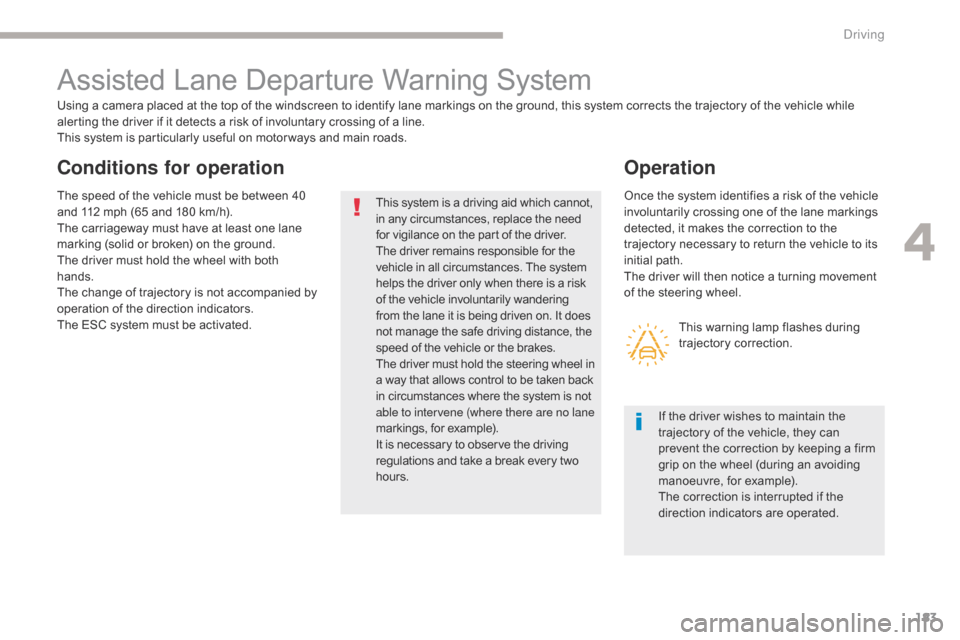
183
C4-Picasso-II_en_Chap04_conduite_ed02-2016
Assisted Lane Departure Warning System
Using a camera placed at the top of the windscreen to identify lane markings on the ground, this system corrects the trajectory of the vehicle while
alerting the driver if it detects a risk of involuntary crossing of a line.
This system is particularly useful on motor ways and main roads.This system is a driving aid which cannot,
in any circumstances, replace the need
for vigilance on the part of the driver.
The driver remains responsible for the
vehicle in all circumstances. The system
helps the driver only when there is a risk
of the vehicle involuntarily wandering
from the lane it is being driven on. It does
not manage the safe driving distance, the
speed of the vehicle or the brakes.
The driver must hold the steering wheel in
a way that allows control to be taken back
in circumstances where the system is not
able to intervene (where there are no lane
markings, for example).
It is necessary to observe the driving
regulations and take a break every two
hours.
Operation
Conditions for operation
The speed of the vehicle must be between 40
and 112 mph (65 and 180 km/h).
The carriageway must have at least one lane
marking (solid or broken) on the ground.
The driver must hold the wheel with both
hands.
The change of trajectory is not accompanied by
operation of the direction indicators.
The ESC system must be activated. Once the system identifies a risk of the vehicle
involuntarily crossing one of the lane markings
detected, it makes the correction to the
trajectory necessary to return the vehicle to its
initial path.
The driver will then notice a turning movement
of the steering wheel.
This warning lamp flashes during
trajectory correction.
If the driver wishes to maintain the
trajectory of the vehicle, they can
prevent the correction by keeping a firm
grip on the wheel (during an avoiding
manoeuvre, for example).
The correction is interrupted if the
direction indicators are operated.
4
Driving
Page 186 of 527
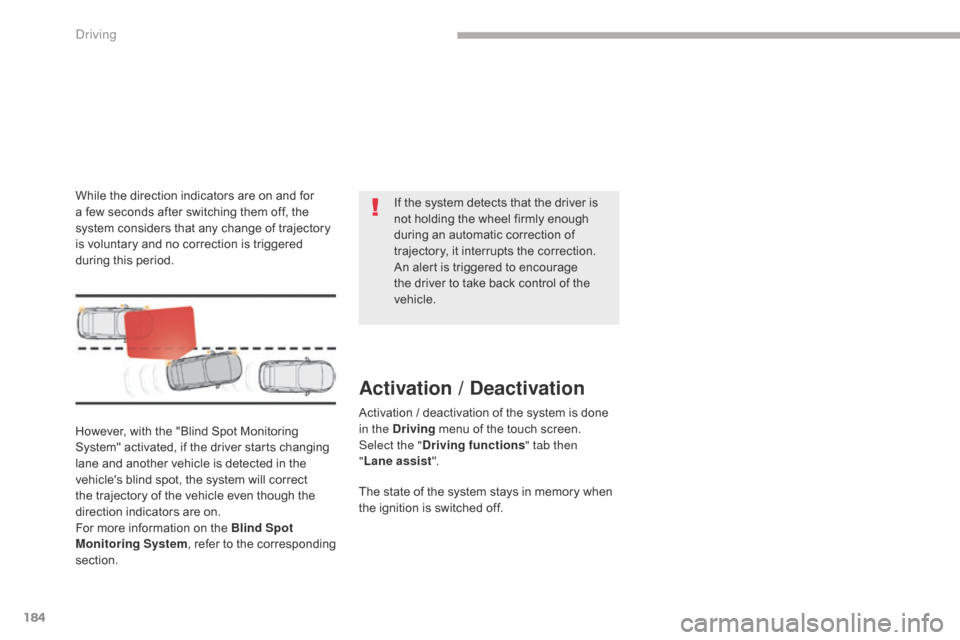
184
C4-Picasso-II_en_Chap04_conduite_ed02-2016
However, with the "Blind Spot Monitoring
System" activated, if the driver starts changing
lane and another vehicle is detected in the
vehicle's blind spot, the system will correct
the trajectory of the vehicle even though the
direction indicators are on.
For more information on the Blind Spot
Monitoring System, refer to the corresponding
section. If the system detects that the driver is
not holding the wheel firmly enough
during an automatic correction of
trajectory, it interrupts the correction.
An alert is triggered to encourage
the driver to take back control of the
vehicle.
Activation / Deactivation
Activation / deactivation of the system is done
in the Driving
menu of the touch screen.
Select the " Driving functions " tab then
" Lane
assist".
The state of the system stays in memory when
the ignition is switched off.
While the direction indicators are on and for
a few seconds after switching them off, the
system considers that any change of trajectory
is voluntary and no correction is triggered
during this period.
Driving
Page 188 of 527
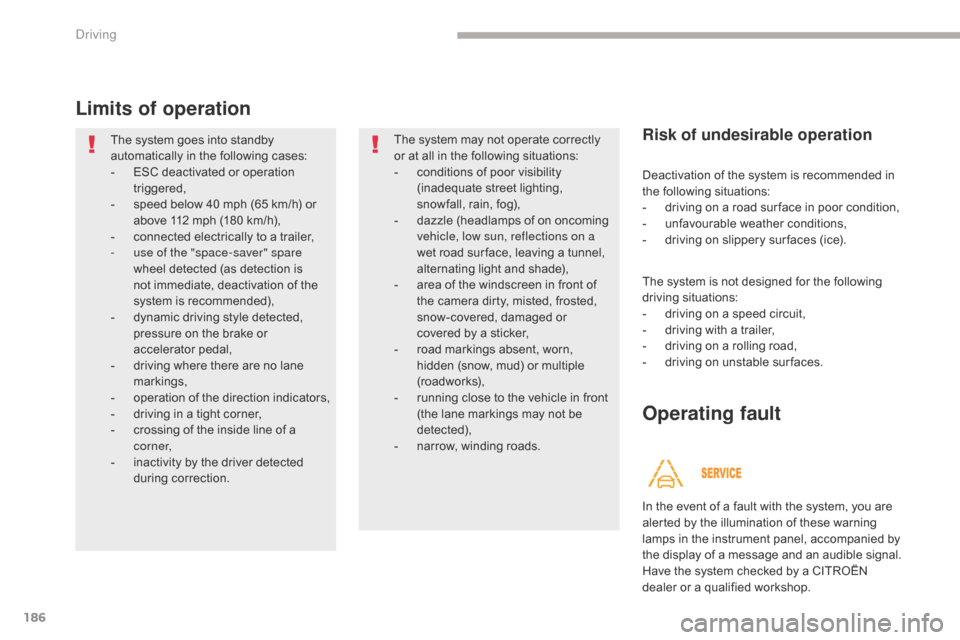
186
C4-Picasso-II_en_Chap04_conduite_ed02-2016
Limits of operation
The system goes into standby
automatically in the following cases:
-
ES
C deactivated or operation
triggered,
-
s
peed below 40 mph (65 km/h) or
above 112 mph (180 km/h),
-
c
onnected electrically to a trailer,
-
u
se of the "space-saver" spare
wheel detected (as detection is
not immediate, deactivation of the
system is recommended),
-
d
ynamic driving style detected,
pressure on the brake or
accelerator pedal,
-
d
riving where there are no lane
markings,
-
ope
ration of the direction indicators,
-
d
riving in a tight corner,
-
c
rossing of the inside line of a
c o r n e r,
-
i
nactivity by the driver detected
during correction. The system may not operate correctly
or at all in the following situations:
-
c
onditions of poor visibility
(inadequate street lighting,
snowfall, rain, fog),
-
d
azzle (headlamps of on oncoming
vehicle, low sun, reflections on a
wet road sur face, leaving a tunnel,
alternating light and shade),
-
a
rea of the windscreen in front of
the camera dirty, misted, frosted,
snow-covered, damaged or
covered by a sticker,
-
r
oad markings absent, worn,
hidden (snow, mud) or multiple
(roadworks),
-
r
unning close to the vehicle in front
(the lane markings may not be
detected),
-
n
arrow, winding roads.Risk of undesirable operation
Deactivation of the system is recommended in
the following situations:
-
d
riving on a road sur face in poor condition,
-
u
nfavourable weather conditions,
-
d
riving on slippery sur faces (ice).
The system is not designed for the following
driving situations:
-
d
riving on a speed circuit,
-
d
riving with a trailer,
-
d
riving on a rolling road,
-
d
riving on unstable sur faces.
In the event of a fault with the system, you are
alerted by the illumination of these warning
lamps in the instrument panel, accompanied by
the display of a message and an audible signal.
Have the system checked by a CITROËN
dealer or a qualified workshop.
Operating fault
Driving
Page 189 of 527
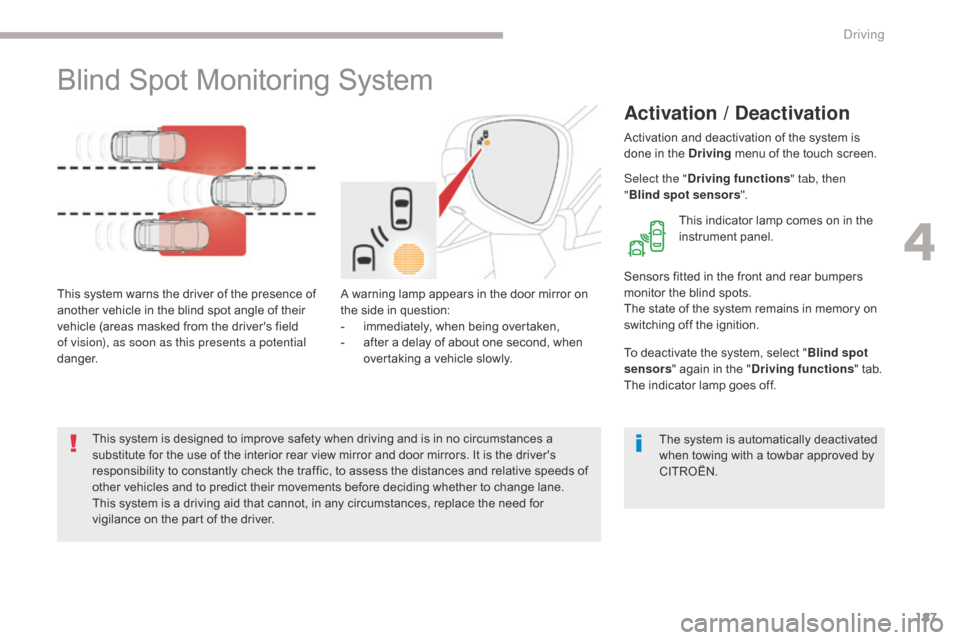
187
C4-Picasso-II_en_Chap04_conduite_ed02-2016
Blind Spot Monitoring System
Activation / Deactivation
A warning lamp appears in the door mirror on
the side in question:
-
i
mmediately, when being overtaken,
-
a
fter a delay of about one second, when
overtaking a vehicle slowly.
This system warns the driver of the presence of
another vehicle in the blind spot angle of their
vehicle (areas masked from the driver's field
of vision), as soon as this presents a potential
danger. Sensors fitted in the front and rear bumpers
monitor the blind spots.
The state of the system remains in memory on
switching off the ignition.
This system is designed to improve safety when driving and is in no circumstances a
substitute for the use of the interior rear view mirror and door mirrors. It is the driver's
responsibility to constantly check the traffic, to assess the distances and relative speeds of
other vehicles and to predict their movements before deciding whether to change lane.
This system is a driving aid that cannot, in any circumstances, replace the need for
vigilance on the part of the driver. Activation and deactivation of the system is
done in the Driving
menu of the touch screen.
Select the " Driving functions " tab, then
" Blind spot sensors ".
This indicator lamp comes on in the
instrument panel.
To deactivate the system, select " Blind spot
sensors " again in the " Driving functions " tab.
The indicator lamp goes off.
The system is automatically deactivated
when towing with a towbar approved by
CITROËN.
4
Driving
Page 191 of 527
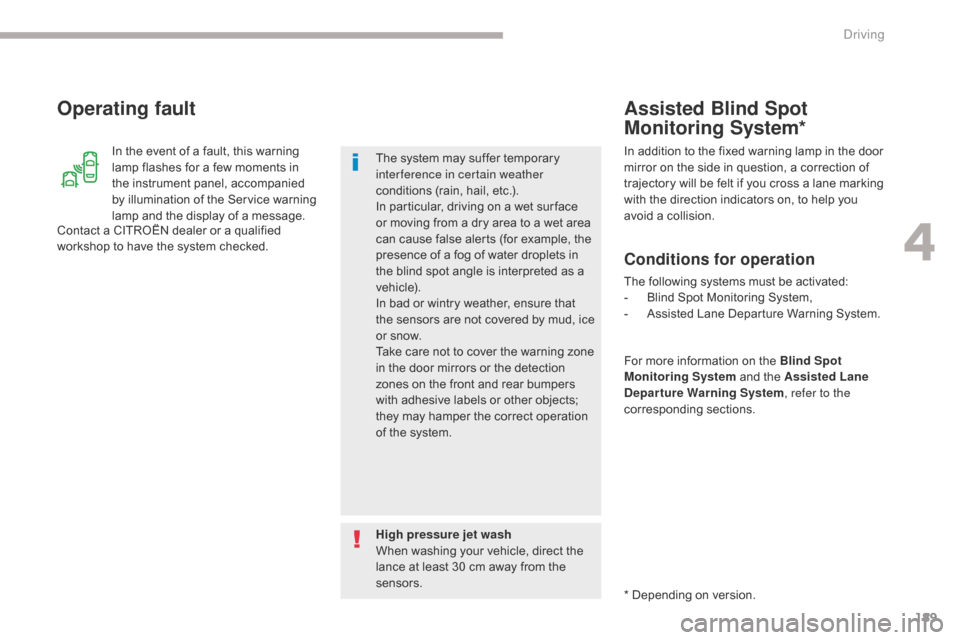
189
C4-Picasso-II_en_Chap04_conduite_ed02-2016
In the event of a fault, this warning
lamp flashes for a few moments in
the instrument panel, accompanied
by illumination of the Service warning
lamp and the display of a message.
Operating fault
Contact a CITROËN dealer or a qualified
workshop to have the system checked.The system may suffer temporary
interference in certain weather
conditions (rain, hail, etc.).
In particular, driving on a wet sur face
or moving from a dry area to a wet area
can cause false alerts (for example, the
presence of a fog of water droplets in
the blind spot angle is interpreted as a
vehicle).
In bad or wintry weather, ensure that
the sensors are not covered by mud, ice
or snow.
Take care not to cover the warning zone
in the door mirrors or the detection
zones on the front and rear bumpers
with adhesive labels or other objects;
they may hamper the correct operation
of the system.
High pressure jet wash
When washing your vehicle, direct the
lance at least 30 cm away from the
sensors.In addition to the fixed warning lamp in the door
mirror on the side in question, a correction of
trajectory will be felt if you cross a lane marking
with the direction indicators on, to help you
avoid a collision.
Conditions for operation
The following systems must be activated:
-
B lind Spot Monitoring System,
-
A
ssisted Lane Departure Warning System.
Assisted Blind Spot
Monitoring System*
For more information on the Blind Spot
Monitoring System and the Assisted Lane
Departure Warning System , refer to the
corresponding sections.
* Depending on version.
4
Driving
Page 195 of 527
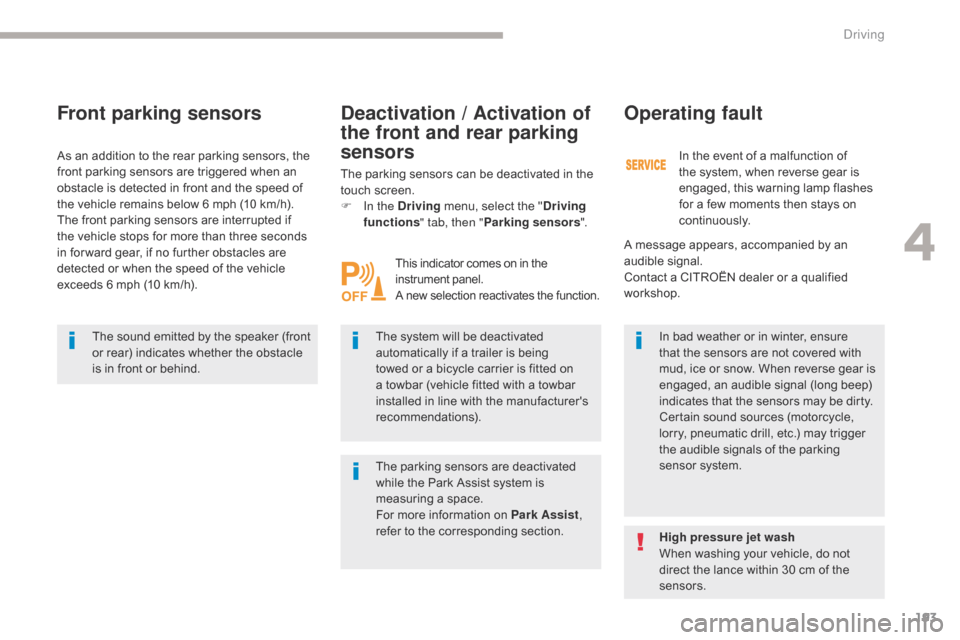
193
C4-Picasso-II_en_Chap04_conduite_ed02-2016
Front parking sensors
The sound emitted by the speaker (front
or rear) indicates whether the obstacle
is in front or behind.The system will be deactivated
automatically if a trailer is being
towed or a bicycle carrier is fitted on
a towbar (vehicle fitted with a towbar
installed in line with the manufacturer's
recommendations).In bad weather or in winter, ensure
that the sensors are not covered with
mud, ice or snow. When reverse gear is
engaged, an audible signal (long beep)
indicates that the sensors may be dirty.
Certain sound sources (motorcycle,
lorry, pneumatic drill, etc.) may trigger
the audible signals of the parking
sensor system.
As an addition to the rear parking sensors, the
front parking sensors are triggered when an
obstacle is detected in front and the speed of
the vehicle remains below 6 mph (10 km/h).
The front parking sensors are interrupted if
the vehicle stops for more than three seconds
in for ward gear, if no further obstacles are
detected or when the speed of the vehicle
exceeds 6 mph (10 km/h).
The parking sensors can be deactivated in the
touch screen.
F
I
n the Driving
menu, select the " Driving
functions " tab, then " Parking sensors ".
Operating fault
In the event of a malfunction of
the system, when reverse gear is
engaged, this warning lamp flashes
for a few moments then stays on
continuously.
This indicator comes on in the
instrument panel.
A new selection reactivates the function.
High pressure jet wash
When washing your vehicle, do not
direct the lance within 30 cm of the
sensors.
The parking sensors are deactivated
while the Park Assist system is
measuring a space.
For more information on Park Assist
,
refer to the corresponding section.
Deactivation / Activation of
the front and rear parking
sensors
A message appears, accompanied by an
audible signal.
Contact a CITROËN dealer or a qualified
workshop.
4
Driving
Page 201 of 527

199
C4-Picasso-II_en_Chap04_conduite_ed02-2016
Operation
Assistance with parallel parking
manoeuvres
F Press this button.To enter a parallel parking space, the
system does not identify spaces that
are clearly smaller or larger than the
vehicle.
This indicator lamp comes on in the
instrument panel to confirm activation
of the function. F
L
imit the speed of the vehicle to
a maximum of 12 mph (20 km/h)
and select " Enter parallel
parking space " in the touch
screen. F
O
perate the direction indicator on the
parking side chosen to activate the
measurement function. You should drive
at a distance of between 0.5 m and 1.5 m
from the row of parked vehicles.
F
D
rive slowly following the instructions until
the system finds a free space.
F
W
hen you have identified a parking space:
4
Driving